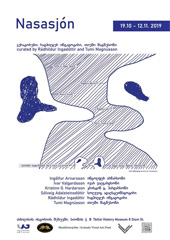
Nasasjon – Exhibition of Icelandic Artist
By Mariam Chanishvili
Tuesday, October 22
Nasasjon – an exhibition of contemporary artists from Iceland consists of works by six Icelandic artists: Ingolfur Arnarsson, Ivar Valgardsson, Kristinn G. Hardarson, Solveig Adalsteinsdottir, Radhildur Ingadottir, and Tumi Magnússon.
All of the artists have a thing in common – come from the same generation, born between 1954 and 1959.
The exhibition opening took place on October 19 at Tbilisi History Museum, presented by Georgian National Museum (GNM). It is planned to be on display until November 19.
Curated by Radhildur Ingadottir and Tumi Magnússon, the exhibition was organized within the framework of the project "Contemporary Art Gallery”.
Born in 1955 in Reykjavík, Hardarson graduated from the Icelandic College of Art and Handicraft in 1977. He studied at the Academy of Fine Arts of Haag.
Ingadottir was born in Reykjavik, Iceland in 1959. She studied art in England from 1980 to 86 and has been active as an artist since then. She had her first solo exhibition in The Living Art Museum in Reykjavík in1986. Radhildur Ingadottir’s approach to art includes text, drawings, sculpture, wall paintings and videos and often these elements are incorporated into expansive installations.
The project was originally conceived for Gallery Olschewski & Behm (now Gallery Kim Behm) on the occasion of Iceland's participation in the Frankfurt International Book-fair, 2011, and has been realized with new works at Peacock Visual Arts, Aberdeen, Scotland, 2014; and in Stadtische Galerie Speyer, Germany, 2017.
“It was repeated with new works in Peacock Visual Arts in Aberdeen, Scotland in 2014.
The artists involved are all of the same generation, born between 1954 and 59. The word Nasasjon means “nose-sight.” It means having a faint notion of something. It is precisely the intention of this exhibition to give a glimpse into the art of this generation of Icelandic artists. It is not put together as an impartial overview of the generation but focused on what the curators see as important artistic output representative of a larger group,” reads the information by the Icelandic Art Center.



